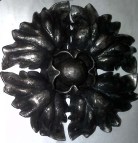A Brief History of the ‘Tijou’ Gates at
Petworth House, West Sussex.
The Gates on the Grand Carriage Drive were commissioned by Henry, 2nd Lord Leconfield in the late 1860’s or early 1870’s.
Lord Leconfield inherited Petworth in 1869 and with his architect Anthony Salvin set about making improvements to the house and park, which had seen little change since the death of the 3rd Earl Egremont in 1837
Lord Leconfield’s Carriage Drive Gates and the Screens (either side of the house) recall iron railings and gates which once enclosed the Grand Courtyard and West Front of Petworth House. The current design is Baroque in style and are based upon Jean Tijou’s (fl.1689-1711). original work at Hampton Court Palace, in particular the Lion Gate and the Fountain Garden Gates. Hence, these beautiful gates at Petworth are locally referred as the ‘Tijou’ Gates.
Amazingly, a preliminary design for the Gates has survived and found in the House Archive: ‘Wr Iron Gates for Park Entrance for the Rt Honl. Lord Leconfield’ by Brawn and Downing, 64 Clement Street, Birmingham (PHA 7646). The surviving Gates and Screens show that Brawn and Downing’s interpretation of Tijou’s design had been simplified from their original proposal, possibly to save money, but more likely to ‘work in’ the view of Petworth Park from the stately home. Brawn and Downing’s design is undated, but the company provided other designs dated 1872, which fits in with the date of Anthony Salvin’s involvement at Petworth.
The gates are designated Grade 1 as they are part of the curtilage of nationally important Petworth House . In 1996 it was noted that the structure was at risk from corrosion damage. A vital conservation decision was approved by the National Trust and the Gate facade was partly dismantled. The ornate overthrow and basket topped crestings from the gate piers, side quadrants, loose Repoussework and Acanthus work was put into secure and dry storage. This controlled action limited the degradation and loss to the precious Wrought Ironwork structure. This was a difficult decision at the time, but ultimately saved the greater proportion of the exquisite leaf work for conservation and restoration at a later date.
Ironically, in 2012 the scenario where Heritage important Wrought Ironwork is under threat, this practice is encouraged. Most responsible owners and Conservators practise it when feasible to do so.



